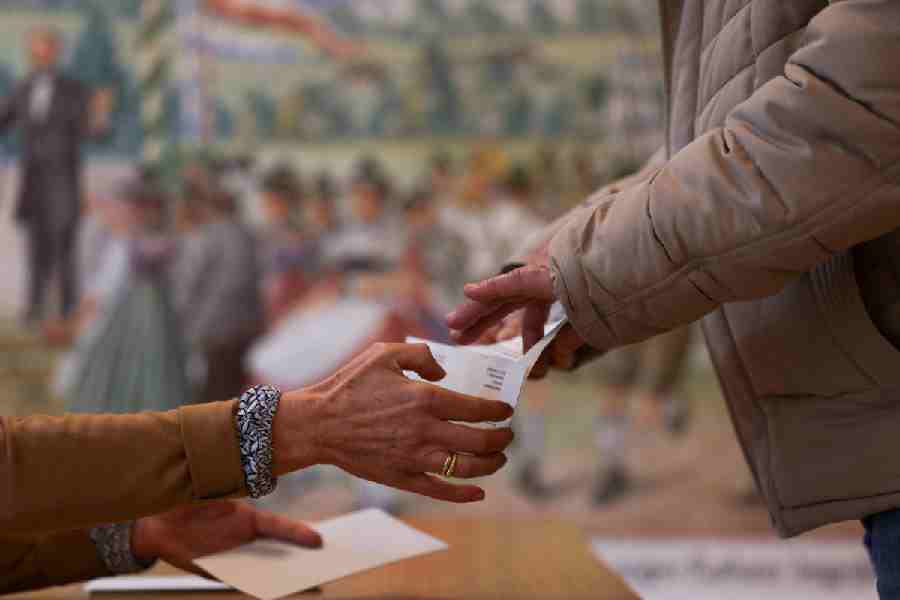 |
| Body against light: Detlef Alexander in Into the Blue I |
Three short pieces of solo dance, each an essay on how “a single body” might live out its limits and possibilities in shifting space. Into the Blue: dance solo for a single body by the Jan Pusch Repertory of Hamburg (Rabindra Sadan, April 7) showed — in its unfaltering precision, clarity and simplicity of design — just how Classical the Modern can be at its best. Each piece brought together three basic elements: the movements of the human body, layers of rhythm and sound of increasing complexity, and a spatial matrix created with digital projections and minimal props. The challenge lay in co-ordinating these elements, without losing sight of the cerebral dimension of the work, of the ideas, questions, fears, hopes and energies that compel each dancer to keep moving in space, tensely and beautifully. Jan Pusch, now in his late 30s, was educated in classical music before he moved on to dancing and choreography. And this trajectory is evident in the structure of his conceptions, in the way bodily movement, rhythmic patterns and geometric lines, planes and forms harmonise with and counterpoint one another, in ever-changing configurations, in his choreography.
The opening number, danced by Detlef Alexander, is a taut but exhilarating duel between the dancer and the dynamic grid of digital images and sounds that tries to engulf his body and pin it down. This spectacular tussle between the natural body and digital technology is played out in time, driven by the inexorable rhythms of Beat Halberschmidt’s minimalist electronic music. Alexander’s sinewy form is continually re-sculpted by the myriad patterns of light and shadow projected behind, around and finally upon it. These patterns threaten to turn the solidness of his body in space into a screen, a brilliantly illuminated absence, whose fleshly counterpart becomes a commanding, but shadowy double. There is delight and an awesome, Blakean beauty in this struggle of the body against light. The dancer resists the dehumanising futurism of the digital media by holding on to the organic simplicity of his body.
The second piece, danced by Wobine Bosch, was subtler and more minutely reflective. Behind a screen of fine, transparent gauze, in the stark, white light of perhaps a blazing noon, a woman’s body, clad in spare, simple clothes, searches out — anxiously, tentatively, yet compulsively — the human meanings of its own presence in space. Projected endoscopic footage of an open mouth and innards threatens, literally, to gobble her up. But she survives — if only to puzzle out her own fears, scruples and questions through a vocalised dialogue, the script of which is projected in large, bold letters upon the gauze screen in front of her. These words go to the heart of the ideas that inform Pusch’s work: how we inhabit our own bodies and then, from that location, go on to experience or imagine the bodies, and minds, of others. It is an “inborn curiosity” about ourselves and others that compels our empathy and our communications, as well as our desires, anxieties and projections. And contemporary dance is a structured and self-reflexive expression of this search for the meanings of the human body. The inset dialogue — lightly probing and unpretentious — takes dance towards an inward theatre. It brings the energies of dance close to the preoccupations of our everyday consciousness, and to the accidents of our everyday encounters.
Paula Scherf’s final solo continues this exploration of the body in an interior space. A low table, a simple chair (the scarlet of whose upholstery is echoed in the dancer’s underwear) and the projection of a Seventies lino pattern on the backdrop defines this space. But strange things happen to this woman. Her shadow scampers away from her in different directions on the floor, and her body replicates itself and climbs up a wall, which occasionally opens up to reveal a regress of similar rooms, with similar furniture and the same woman in triplicate, doing slightly different things simultaneously.
The actual dancer is therefore confronted with her multiple selves, just as her natural, unamplified voice, anxiously muttering dates and times set mostly in the future, is contrasted with the hugely amplified electronic soundtrack. There is a sort of nimble exasperation in her desperate little movements; she also seems to be fighting against a boredom, welling up inside her, with the limits of what she can actually do with her own body. The possibilites of digital technology are exciting and irresistible. Bodies multiply, shadows live, flesh becomes light, and the most ordinary noises re-mastered lend to our mundane actions a dimension of obscure drama. But Jan Pusch’s last piece ends with a little collapse, as the dancer’s body flops on the table in tragicomic despair. At her wit’s end, she confronts, and then acts out, the essential loneliness of the solo dancer in search of the future of her own body and of her own art.










